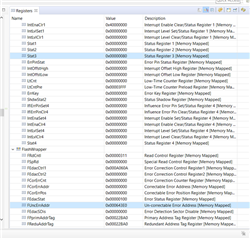Other Parts Discussed in Thread: UNIFLASH, NOWECC,
Hello, I am debugging some legacy code, and I am getting an unexpected ECC error.
Our project has multiple hex files programmed to a TMS5703137CGWTQEP.
The CAN Bootloader (CBL), in BANK 0 Sector 0
The PDIF. in BANK 0 Sector 3 (This is just parameter memory, no execution code)
The APP, in Bank 0 Sector 4
The CBL and APP do NOT have ECC setup in their linker files.
The CBL does not turn on ECC for FLASH.
The APP DOES turn on ECC for FLASH in sys_startup.c with library function _coreEnableFlashEcc_();
We have the nERROR connected to a RED LED, so if I slip and say RED light On, that's what I'm referring to.
My issue is, when I use Uniflash 6.1.0.2829 with Auto ECC turn ON, to program all three software at once, I would expect no ECC errors.
However, my Red Light is in fact coming on. Debugging the registers, I see the following:
Stat3 and FEdacStat show that this the Group 3 Channel 7 error, which is the Uncorrectable FMC bus error
The address of 0x000643E0 is off in Bank 0 Sector 6, which we do NOT program or write to.
The APP also checks for group3 errors in sys_startup.c and and would restart with watchdog if any occur for this startup check, but this is NOT triggering.
So clearly my group3 error is occurring after startup some how.
So, I'm honestly a bit confused that I'm getting a FLASH ECC error even when I program everything with Uniflash with Auto ECC turned on.
Any advice is appreciated.

